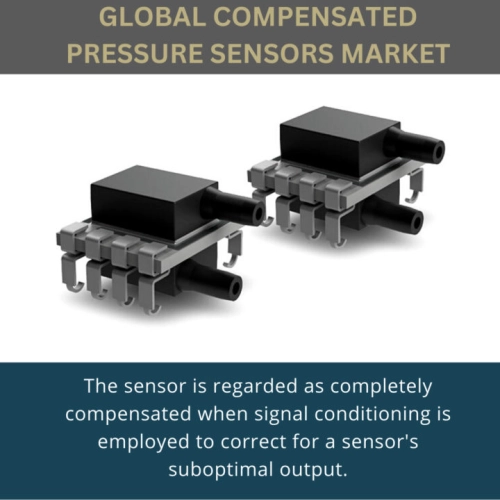
- Get in Touch with Us

Last Updated: Apr 25, 2025 | Study Period: 2022-2030
Pressure sensors with compensation methods The sensor is regarded as completely compensated when signal conditioning is employed to correct for a sensor's suboptimal output.

The resistor characteristics and performance of a sensor are altered using laser-trimming technology; this is referred to as passive compensation.
A measure to offset or compensate for an unfavorable temperature effect is referred to as temperature compensation.
A sensor's measured value should never again be impacted by a temperature change thanks to temperature compensation.
The global compensated pressure sensors market accounted for $XX Billion in 2021 and is anticipated to reach $XX Billion by 2030, registering a CAGR of XX% from 2022 to 2030.
TE Connectivity HDO compensated pressure sensors.
The HDO pressure sensors are designed for use with dry, non-corrosive gasses and are calibrated and temperature corrected.
The sensors come in a variety of common pressure ranges. Furthermore, First Sensor may offer requested bespoke calibrations and pressure ranges. Space-saving PCB installation and maximal OEM design flexibility are made possible by tiny SMT housings.
Common uses include industrial, pneumatic, environmental controls, HVAC, medical equipment, and instrumentation.
Analog Microelectronics' AMS 5612 - Temperature Compensated OEM Pressure Sensor. A series of PCB-mountable pressure sensors called AMS 5612 are calibrated and compensated in the 0 to 60 °C temperature range and provide an unamplified ratiometric mV-output.
They come with metal pressure ports and a ceramic DIP packaging. The sensors have an extremely quick response time as a result of the analogue measuring technique.
| Sl no | Topic |
| 1 | Market Segmentation |
| 2 | Scope of the report |
| 3 | Abbreviations |
| 4 | Research Methodology |
| 5 | Executive Summary |
| 6 | Introduction |
| 7 | Insights from Industry stakeholders |
| 8 | Cost breakdown of Product by sub-components and average profit margin |
| 9 | Disruptive innovation in the Industry |
| 10 | Technology trends in the Industry |
| 11 | Consumer trends in the industry |
| 12 | Recent Production Milestones |
| 13 | Component Manufacturing in US, EU and China |
| 14 | COVID-19 impact on overall market |
| 15 | COVID-19 impact on Production of components |
| 16 | COVID-19 impact on Point of sale |
| 17 | Market Segmentation, Dynamics and Forecast by Geography, 2022-2030 |
| 18 | Market Segmentation, Dynamics and Forecast by Product Type, 2022-2030 |
| 19 | Market Segmentation, Dynamics and Forecast by Application, 2022-2030 |
| 20 | Market Segmentation, Dynamics and Forecast by End use, 2022-2030 |
| 21 | Product installation rate by OEM, 2022 |
| 22 | Incline/Decline in Average B-2-B selling price in past 5 years |
| 23 | Competition from substitute products |
| 24 | Gross margin and average profitability of suppliers |
| 25 | New product development in past 12 months |
| 26 | M&A in past 12 months |
| 27 | Growth strategy of leading players |
| 28 | Market share of vendors, 2022 |
| 29 | Company Profiles |
| 30 | Unmet needs and opportunity for new suppliers |
| 31 | Conclusion |
| 32 | Appendix |